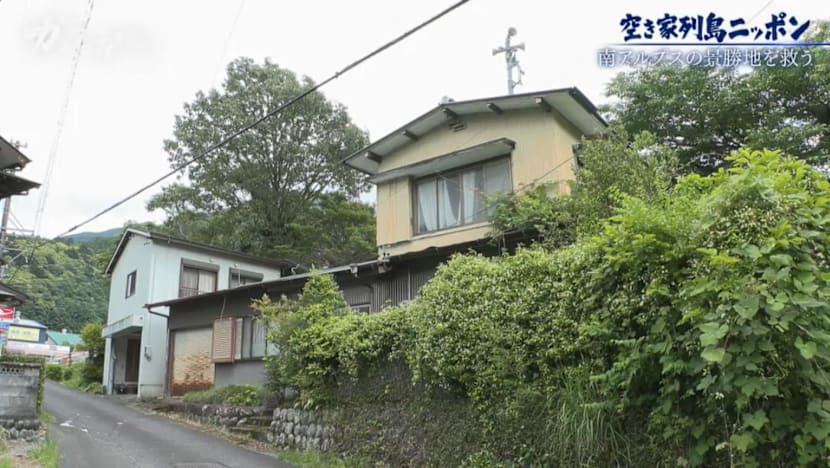Entertainment
Japan’s Vacant Homes Crisis: Communities Seek Solutions

Japan is grappling with a significant challenge as the number of vacant homes continues to rise, prompting officials and families to pursue various solutions. In Setagaya Ward, a bustling area in Tokyo with approximately 510,000 households, authorities have identified 13 properties deemed dangerous due to neglect. One such house, nearly engulfed by vines, has a collapsed roof and a narrow, rusted entrance. “Do not go in too far. It could collapse,” warns Taeko Chiba, the ward’s chief officer for vacant houses.
These abandoned structures not only attract pests but also pose serious structural risks, sometimes becoming havens for criminal activity. The local government faces the challenge of demolishing these properties, often recovering costs from their owners, who also lose tax benefits and incur significantly higher property taxes. The vacant house issue is not isolated; Japan currently has over 9 million empty homes, equating to roughly one in seven properties nationwide. Setagaya alone is home to around 58,000 vacant houses, the highest number in the country.
The repercussions extend beyond visual blight. An unoccupied home can decrease the value of neighboring properties by approximately 3 percent. Without intervention, entire communities risk deterioration. “If nobody acts, Japan will be full of empty houses,” the narrator warns in a documentary highlighting the crisis.
To combat this trend, Setagaya has established a dedicated department for vacant houses and partnered with Vacant House Utilisation Co., chaired by Takamitsu Wada. Their initiative, Setagaya Vacant House Navi, offers a free consultation service to residents, connecting them with experts to explore options for their properties. “The key is to act before a home becomes vacant,” Wada emphasizes, noting that emotional attachments often paralyze families from making decisions about their inherited homes.
One poignant example is the story of Mr. Ogawa’s family. His mother’s house, built 65 years ago, has remained empty for four years. “Having my own home was something I always took pride in,” she reflects, recalling the pride her late husband had for their home. Ultimately, they decided to demolish it and sell the land, recognizing the necessity of moving forward. “You cannot take it with you to the next world,” the 84-year-old homeowner adds, advocating for a peaceful division of the property among heirs.
The challenges of vacant homes are not confined to urban settings. In rural Kawanehon, Shizuoka, the situation takes a different form, with one in four houses sitting empty in a community of just over 5,000 residents. The town has established a Vacant House Bank to list properties available for sale or renovation, yet demand remains low. A two-storey house priced at 2.6 million yen (approximately $24,000) has been listed for three years with little interest. Renovation costs often outweigh the properties’ market value, as noted by property assessor Atsushi Kuroda.
To encourage revitalization, Kawanehon now offers subsidies of up to 2 million yen for renovations. Plans are also in place to convert some properties into rental homes to attract new residents. “We cannot clear all the vacant homes ourselves,” says local official Hajime Ogasawara. “But we can create a movement.”
In Taketa City, Oita, century-old homes similarly languish unoccupied. Shoji Manabe, who inherited a historic house from his grandfather, has struggled with the decision to sell, ultimately choosing to part with it for just 10 yen. The cost of renovating the home is expected to exceed 15 million yen. “Maintaining a 110-year-old home carries value beyond money,” Manabe notes, emphasizing the emotional connection tied to such properties.
Experts like architect Hiroki Suzuki and social entrepreneur Wada are collaborating on revitalization efforts, aiming to transform these homes into guest accommodations. “Can it make money, bring excitement and create something new?” Wada asks, highlighting the dual objectives of financial viability and community enrichment.
Chiba continues her work in Setagaya, equipped with a home closure guidebook designed to assist residents in navigating the complex emotions and processes associated with selling or demolishing their homes. “The essence of the problem is that people simply do not know who to consult,” Wada explains, noting that these homes represent not just physical structures but also family history and identity.
As Japan faces the reality of its vacant homes crisis, a quiet movement is emerging, aiming to address the issue one property at a time. The emotional weight of these decisions is significant, but with increased awareness and support, communities can begin to reverse the trend of abandonment, ensuring that homes retain their place in the fabric of family and community history.
-

 Business5 months ago
Business5 months agoKenvue Dismisses CEO Thibaut Mongon as Strategic Review Advances
-

 Lifestyle4 months ago
Lifestyle4 months agoHumanism Camp Engages 250 Youths in Summer Fest 2025
-

 Sports4 months ago
Sports4 months agoDe Minaur Triumphs at Washington Open After Thrilling Comeback
-

 Sports5 months ago
Sports5 months agoTupou and Daugunu Join First Nations Squad for Lions Clash
-

 Top Stories5 months ago
Top Stories5 months agoColombian Senator Miguel Uribe Shows Signs of Recovery After Attack
-

 World5 months ago
World5 months agoASEAN Gears Up for Historic Joint Meeting of Foreign and Economic Ministers
-

 Health4 months ago
Health4 months agoNew Study Challenges Assumptions About Aging and Inflammation
-

 Business5 months ago
Business5 months agoOil Prices Surge Following New EU Sanctions on Russia
-

 Entertainment4 months ago
Entertainment4 months agoDetaşe-Sabah Violin Ensemble Captivates at Gabala Music Festival
-

 Entertainment4 months ago
Entertainment4 months agoBaku Metro Extends Hours for Justin Timberlake Concert
-

 Top Stories5 months ago
Top Stories5 months agoRethinking Singapore’s F&B Regulations Amid Business Closures
-

 Business5 months ago
Business5 months agoU.S. House Approves Stablecoin Bill, Sends to Trump for Signature









